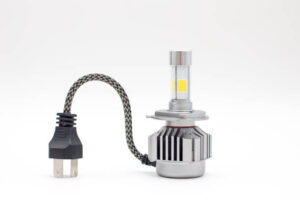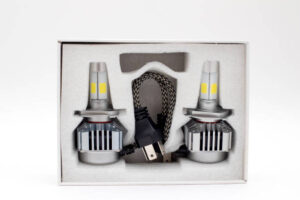The Highway Hero (The Unsung)
Refurbishing the old jewel or wheeling around an old trusted gas guzzler? It is a color that relates to a time travel similarly to taking a step back in time. However, you would not like the lighting technology in your ride to be in the past. Meet the real star that few people pay attention to which is the h4 led headlight hidden safely behind the chrome grilles and the glass covering the headlamps.

H4 bulb is not a news item to vintage car enthusiasts. It owns disco, shoulder pads and mixtapes. However, modern H4 LED upgrades turn this little whimper of old into a howl, illuminating the midnight highway just like a rolling spotlight.
Dual-Beam Drama- Why Two in One Wins His Race
Halogen H4 bulbs were never ordinary since they had the characteristic dual-filament trickiness. One globe, two functions: High beam-low beam. Easy to use, nifty, and cannot be matched in case you prefer one-stop-shop style of solutions.
So, repeat the intensity, add present-day economy, and increase the clearness. That is the magic the H4 LED is going to bring to the party. He takes the sandwich baton of the two-in-one, and dashes, without breathing hard.
Change the switch on low beam in the city and high beam in the empty roads. Same bulb, but there is just so much light, that halogens are falling on their knees in its presence.
There is more to a Pretty Beam than meets the Eye: The Real Numbers
Let us get down to reality. A typical halogen H4 emits perhaps a 1,000 lumens on low, perhaps 1,500 on high. And after a switch to H4 LEDs, you are reveling in as much as 6,000 lumens. The figures do not lie. There is no competition.
The light with H4 LEDs is not only more abundant, but it is cleaner. About 6,000 kelvin is to be expected: imagine sun in the morning as compared to yellow mud. Number plate writes jumps. Street signs light up as though something painted them.
This is not just for appearance purposes. The upgrades that count are faster reaction times, less squinting, and more comfort when driving at nights.
Energy Upside: The Classic Cars Best Friend
The wiring on any classic vehicle is touchy. Amp draw is a four letter word to those who have vintage fuses. Halogenes are power glutton. LEDs by contrast hardly drink it.
The voltage required by most H4 LEDs ranges between 20 and 40 watts in comparison to 60 or 70 watts of a dual-filament halogen. Less load on older alternators and wiring too, which is welcome on vehicles where a good battery is as scarce as a pair of 1970s wheel discs.
With LEDs being a lot cooler, headlight housings and reflectors stay longer. No more fried egg appearance behind your glass lenses!
Plug and Play: Moderneration without Wrenching
What about one of the delights of an H4 LED headlight conversion? Bone struggling with your car is done away with. No swearing at haphazard wiring or cutting at trace wires behind dash.

A glove and a dose of elbow grease are the most basic things most kits request. Remove the worn out bulb, put in the new LED and you are good to go. Vintage sedans are not the only type of cars that benefit because others like classic motorcycles such as the British twins and old Japanese favorites also benefit as well.
Once in transit, one of my friends simply changed the headlights of his Lotus Seven in the parking lot of a gas station using only a headlamp screwdriver and a touch of encouragement at midnight. Zero drama, new technology, old car.
Can Classic Be Classic No More? Absolutely.
It relates to some myth circulating online discussion boards that LED headlights are too much of a modern touch which is an offensive contrast on the old vehicles. This is the good news; H4 LEDs are coming in every possible form including those that replicate the color tones of past days that were warm.
To the purists you can choose bulbs which give off a subtler, more yellow glow, harking back to old school character and combining it with high tech reliability. Need a full daylight effect around the week night rallies? Select a white- output H4 LED.
and light-emitting diode (LED) filament bulbs are in, resembling the old glass-filament bulbs but using modern LEDs. Show judges? You will pass muster so long as your installation keeps things clean and within the law.
HEADLIGHT FOCUS OF LIGHT: Deal Breaker Or Deal Maker?
Beam pattern ruptures or upgrades. Classical reflectors clearly favored halogens since they were equal to the original engineering. Be sloppy with placement of LEDs and you have the possibility of scattered light, which is disabling to others, much less you.
Respectable H4 LEDs have engineered chip positioning itself so that the low beam will be placed at the ideal position on the reflector. The consequence is that low beam has a sharp cutoff and the high beam is broad and safe. Other drivers were given no wild flashes. No humiliating honking of passing cars asking you to dim your lights!
Reliability: Classic Cars do not like surprises
Most vintage rides give us plenty of mechanical surprises of their own, shall we say. Big-time flaky ignitions, idling hiccups, unexplainable rattling–all of these things are very charming. Car headlights that go immediately we have fog should also not qualify.
LEDs are marathons in snooker outfit. The halogens may exhaust after 1,000 hours. H4 LEDs? 30 000 or more hours. It is likely that that is how much you are going to drive that dream car regardless how many years it takes you to put it in the garage.
Every be Daily, Every night

Old cars should be even fun to use even at night. A headlight LED lights up every night as a victory lap. The increased visibility, reduced load on the original wiring, automatic switching of high and low beams, and the look that suits your vehicle, and best of all, easy to install.
Not a lot of improvements come with as many positive consequences, and without distorting the essence of your traditional vehicle. The next time you are about to hide the keys once the sun goes down, think twice. The two-beam champ is back on the road and the guy is brighter than ever.